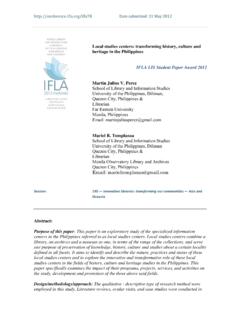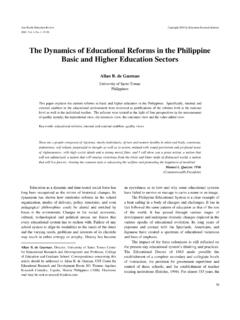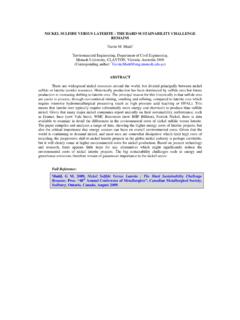Transcription of Indonesia Economic Outlook 2021 - LPEM
1 MACROECONOMIC ANALYSIS SERIES Indonesia Economic Outlook 2021 Key Figures GDP Growth (Q2 20) Inflation ( Oct 20) Credit Growth ( Aug 20) BI Reverse Repo Rate (7-day, Oct 20) Current Account Deficit (CAD) (Q2 20) IDR/USD (Oct 20) IDR14,758 Macroeconomic & Financial Sector Policy Research Jahen F. Rezki, Syahda Sabrina Nauli A. Desdiani Teuku Riefky Amalia Cesarina Meila Husna 1 To keep you updated with our free monthly and quarterly reports, please subscribe. Scan the QR code belowor go to The Great Escape: Covid-19 in the Short-Term and Middle-Income Trap in the Long-Term Highlights As the pandemic persists and will not be ending in the foreseeable future, GDP growth in Q3-2020 is expected to reach to ; around to for overall 2020.
2 The fall into the textbook definition of recession as we almost certainly record the second consecutive negative quarterly GDP growth should not be a concern for anyone; rather, all should lie their focus on the effort of health crisis management. Whether Economic growth can be accelerated and sustained over the long-term will highly depend on the investment that is important for industrialization aiming to increase the value-added of the output. To attract investment, efficiency in labor market is one of the crucial factors which will also help to maintain labor s living standard. The halted Economic activity has been reflected more vividly in the Q2-2020 with the top contributor sectors experienced a more profound negative growth. The current inflation figure shows that aggregate demand is still at its lowest level during the pandemic and there is no definite sign of crisis ending in the near future.
3 Significant improvement in trade figure is unlikely to be achieved, at least in the next few months, as the pandemic would not disappear entirely at any time soon and the resurgence of Covid-19 pandemic in some recovered countries would be likely to happen. Economic activities continue to shrink in Q2-2020 where Economic growth plunged to ( ), much lower than the positive growth in Q1-2020 of The health crisis has halted the economy in nearly all Economic sectors with the top three sectors of Indonesia s economy (manufacturing, wholesale & retail trade, and construction sectors) experienced a more profound negative growth compared to the overall economy. Moreover, Economic downturn was also fully reflected in the expenditure side, where the household consumption s growth dropped to ( ) from its positive growth in Q1-2020 of Mobility restriction, precautionary behavior, and labor income losses have led to a sharp contraction in almost all subsectors in consumption, except consumption in health & education and equipment.
4 The limited business activities and household consumptions contributed to the slow credit growth. The low inflation figure during this health crisis also confirms that aggregate demand is still at its lowest level. While from the external sectors, trade continued to decline from its pre-pandemic level due to lower global demand and supply, though the figure has been slightly improving since July which is recorded by positive monthly growth. However, the deeper drop in imports than exports has contributed to the surplus in trade balance and lower CAD which is stood at US$ billion or equal to of GDP in Q2-2020. Table 1: LPEM FEB UI GDP Growth Forecast Q3-2020 FY 2020 FY 2021 to to to We see that external pressures will endure in the remaining quarters of 2020 as the potential resurgence of Covid-19 pandemic in some recovered countries is looming.
5 If the global demand drops, CAD will remain between of GDP in Q3-2020 and for FY2020. From domestic side, people still hold back their consumption to the pre-pandemic level. Hence, there is limited sign of purchasing power improvement, at least for the next few months, as we are still uncertain of how long this crisis will take place. it is quite a certainty that the economy will still be under stress at least for this year; thus, we predict that the GDP growth for Q3-2020 and FY2020 will be on the negative territory. The Economic growth is estimated to reach as low as to in Q3-2020; making the growth for FY2020 at around to During this hard time, the focus and implementation of virus MACROECONOMIC ANALYSIS SERIES Indonesia Economic Outlook 2021 2 containment strategy will play a vital role in Indonesia s Economic condition.
6 It has been demonstrated by many countries that are already far ahead of us in terms of recovery that it is rather impossible to have an Economic recovery without health recovery. Given the health crisis has been handled and the recovery strategy through monetary and fiscal stimulus has been implemented in an effective manner, we predict that GDP growth will be back into a positive territory and could reach its pre-pandemic level in 2021. Pathway to High-Income Country : Are We Growing Enough? Trapped in the Middle Man is an animal that makes bargains: no other animal does this no dog exchanges bones with another, wrote Adam Smith more than 200 years ago, which pointed out that conducting Economic activity is one of the most basic human natures. From a broader perspective, he also wrote: No society can flourish of which the greater part is poor and miserable.
7 Both quotes were written on the same manifesto called An Inquiry into the Nature and Causes of the Wealth of Nations , popularly referred to by its shortened title the Wealth of Nations , which lays a philosophical ground for Economic as a science and deemed as the fundamental work in classical economics. Since then, Adam Smith s work has driven numerous progressive concepts in the modern Economic era, and one of the most revolutionary concepts is specialization . In the context of labor, specialization is the foundation of the division of labor based on their skills. On the national level, it serves as the ground concept of globalization , in which a country would produce certain goods and services that they have more efficiency or comparative advantage in doing so, while would purchase the rest of the goods and services from other countries which could produce those more efficiently, theoretically.
8 In the modern era, countries, businesses, and modern-era Economic agents worldwide put Economic growth as one of their utmost agendas as Economic growth is considered the primary means to secure prosperity and welfare. However, the path to achieving long-run Economic growth is a complicated matter. The dynamic of political, geographical, and socioeconomic aspects (among others) shapes the nation s Economic growth path trajectory, and those aspects are growing more complex as time goes forward. While several western nations, such as the and Western European countries have managed to attain stable Economic growth in the past and managed to become high-income countries , many developing countries are still struggling to maintain and improve their Economic growth sustainably, including Indonesia .
9 Historically, Indonesia has experienced dramatic changes in Economic conditions, driven by a startling shift in political governance, structural formation, and commodity reliance. As a country with the fourth-biggest population in the world and the seventh-largest economy (in PPP terms), Indonesia experienced a relatively a continuous Economic decline for at least half a century before the mid-1960s (Van der Eng, 2002) and considered as one of the world s poorest countries back then. However, a phenomenal turn of events took place. After 1966, Indonesia enacted tremendous Economic advancement for the next three decades as it managed to quadruple its GDP during this period and was deemed as one of the East Asian Economic Miracles until Asian Financial Crisis battered in 1997.
10 Just as surprising as the previous recovery, Indonesia s economy recovered quickly and returned to a moderately strong growth trajectory of around 5 to 6% from 2000 until now. During that period, Indonesia s growth engine is driven by commodity and natural resources ( , coal, oil, and palm products), coupled with a considerable industrialization process. However, the historical achievement of continuous high Economic growth and industrialization progress is far from advancing Indonesia s status into a high-income country . Specifically, the risk of a middle-income trap poses a severe challenge in its path towards achieving such status. Unfortunately, MACROECONOMIC ANALYSIS SERIES Indonesia Economic Outlook 2021 3 several signs of a middle-income trap characterized by low investment growth, slowing growth of the manufacturing, limited industrial diversification, and poor labor market conditions are somewhat reflected in Indonesia s current state.





